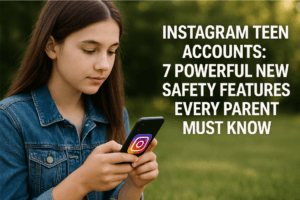Instagram Teen Accounts: 7 Powerful New Safety Features Every Parent Must Know
Instagram is intensifying efforts to protect underage users with its Teen Accounts initiative, now active for over 54 million teens globally, including recent expansions in India, Japan, and Indonesia. These accounts enforce strict safeguards: default private settings for users under 16, restrictions on communication with strangers, content filters to block sensitive material, and a “sleep mode” muting notifications overnight to promote healthier habits.
Age verification remains a priority, combining AI-driven checks for discrepancies, third-party tools, and plans to leverage app store data. Parents must approve any shift to public profiles for teens under 16, with 97% opting to retain restrictive settings, reflecting teen acceptance of these boundaries. At a recent safety forum, experts like Twinkle Khanna emphasized balancing autonomy and protection, acknowledging teens’ desire for independence while prioritizing safety.
Instagram’s strategy aims to reduce parental oversight burdens through automated safeguards, though challenges persist in ensuring age accuracy and preventing platform migration. This shift underscores a broader tech industry imperative—prioritizing youth safety without stifling digital engagement.

Instagram Teen Accounts: 7 Powerful New Safety Features Every Parent Must Know
As concerns about young users’ online safety grow, Instagram is rolling out significant updates to its Teen Accounts globally, aiming to create a safer ecosystem while alleviating parental anxieties. With over 54 million underage users already enrolled worldwide—and recent expansions in India, Japan, and Indonesia—the platform is prioritizing restrictive defaults, age verification, and proactive parental oversight.
Built-In Protections for Young Users
Teen Accounts automatically apply the platform’s strictest safety settings for users under 18. Key features include:
- Privacy by Default: Accounts for users under 16 are set to private, requiring parental approval to switch to public.
- Communication Limits: Teens can only be contacted, tagged, or mentioned by existing connections, reducing exposure to strangers.
- Content Filters: Algorithms restrict sensitive or “icky” content, tailored to younger audiences.
- Usage Controls: A nightly “sleep mode” (10 PM–7 AM) mutes notifications, encouraging healthier screen habits.
Age Verification: Tackling an Industry-Wide Challenge
Accurately verifying ages remains a hurdle, but Instagram is deploying multi-layered strategies:
- AI-Driven Signals: Monitoring for discrepancies, such as sudden age changes or mismatches between profile photos and stated ages.
- Third-Party Tools: Partnering with a UK-based age verification firm, though specifics remain undisclosed.
- App Store Data: Future plans include cross-referencing age data from app store registrations.
Tara Hopkins, Instagram’s Global Public Policy Director, acknowledges the difficulty but emphasizes progress: “We’ve seen fewer attempts to bypass age controls than anticipated—a positive sign.”
Shifting the Burden from Parents to Platforms
A core goal is reducing parental oversight demands. For teens under 16 seeking public accounts, guardians must approve via Instagram’s Parental Supervision tools. Once enabled, parents gain insights into their child’s activity but cannot override settings without discussion. Hopkins notes that 97% of 13–15-year-olds retain the strictest defaults, suggesting teens value these boundaries.
Cultural Shifts and Challenges
At Meta’s recent Teen Safety Forum in India, author Twinkle Khanna highlighted the tension between protection and autonomy: “Teens crave independence, but safety can’t be optional.” The event stressed collaboration among parents, educators, and platforms to foster trust.
The Road Ahead
While early adoption is promising, questions linger. Will restrictive settings drive teens to less-regulated platforms? How effective are age checks against sophisticated fraud? Instagram’s bet is that transparency and default safeguards will build long-term trust. For parents, the changes offer reassurance—but as Hopkins admits, “No solution is perfect. It’s about evolving with the risks.”
As digital landscapes grow more complex, Instagram’s approach reflects a broader industry reckoning: balancing youth autonomy with safety isn’t just a feature—it’s a responsibility.
You must be logged in to post a comment.